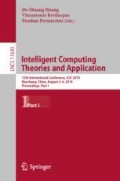Abstract
Feature extraction technique aiming at obtaining discriminative information from high-dimensional face images is of great importance in face recognition. One widely used method for extracting primary feature is Principal Component Analysis (PCA), which uses projection matrix for dimensionality reduction. There are many improvements of PCA but no one pays attention to the fact that both facial images and facial expression are symmetrical to some degree. Facial symmetry is a helpful characteristic, which benefits of feature extraction. In this paper, Mirror Principal Component Analysis (Mirror PCA) method is proposed for extracting representative facial features, which takes advantage of the facial symmetry in a face image. In order to verify the effectiveness of the proposed method, we compare the Mirror PCA method with other four methods on four famous face databases. The experimental results indicate that the representation capacity of our method is superior to others.
Access this chapter
Tax calculation will be finalised at checkout
Purchases are for personal use only
References
Kirby, M., Sirovich, L.: Application of the Karhunen-Loeve procedure for the characterization of human faces. IEEE Trans. Pattern Anal. Mach. Intell. 12, 103–108 (1990)
Fang, X., et al.: Approximate low-rank projection learning for feature extraction. IEEE Trans. Neural Netw. Learn. Syst. 29, 1–14 (2018)
Xu, Y., Zhang, D.: Represent and fuse bimodal biometric images at the feature level: complex-matrix-based fusion scheme. Opt. Eng. 49, 037002 (2010)
Elgallad, E.A., Charfi, N., Alimi, A.M., Ouarda, W.: Human identity recognition using sparse auto encoder for texture information representation in palmprint images based on voting technique. In: Computer Science & Information Technology (2018)
Reza, M.S., Ma, J.: ICA and PCA integrated feature extraction for classification. In: IEEE International Conference on Signal Processing (2017)
Yoo, C.H., Kim, S.W., Jung, J.Y., Ko, S.J.: High-dimensional feature extraction using bit-plane decomposition of local binary patterns for robust face recognition. J. Vis. Commun. Image Represent. 45, 11–19 (2017)
Lu, Y., Lai, Z., Xu, Y., Li, X., Zhang, D., Yuan, C.: Low-rank preserving projections. IEEE Trans. Cybern. 46, 1900–1913 (2016)
Jolliffe, I.: Principal Component Analysis. Springer, Heidelberg (2011)
Yang, J., Zhang, D.D., Frangi, A.F., Yang, J.-Y.: Two-dimensional PCA: a new approach to appearance-based face representation and recognition. IEEE Trans. Pattern Anal. Mach. Intell. 26, 131–137 (2004)
Kong, H., Wang, L., Teoh, E.K., Li, X., Wang, J.-G., Venkateswarlu, R.: Generalized 2D principal component analysis for face image representation and recognition. Neural Netw. 18, 585–594 (2005)
Li, X., Pang, Y., Yuan, Y.: L1-norm-based 2DPCA. IEEE Trans. Syst. Man Cybern. Part B (Cybern.) 40, 1170–1175 (2010)
Kim, Y.-G., Song, Y.-J., Chang, U.-D., Kim, D.-W., Yun, T.-S., Ahn, J.-H.: Face recognition using a fusion method based on bidirectional 2DPCA. Appl. Math. Comput. 205, 601–607 (2008)
Kim, C., Choi, C.-H.: Image covariance-based subspace method for face recognition. Pattern Recogn. 40, 1592–1604 (2007)
Wang, H.: Block principal component analysis with L1-norm for image analysis. Pattern Recogn. Lett. 33, 537–542 (2012)
Ng, A.Y.: Feature selection, L 1 vs. L 2 regularization, and rotational invariance. In: Proceedings of the Twenty-First International Conference on Machine Learning, p. 78. ACM (2004)
Ke, Q., Kanade, T.: Robust L/sub 1/norm factorization in the presence of outliers and missing data by alternative convex programming. In: 2005 IEEE Computer Society Conference on Computer Vision and Pattern Recognition (CVPR 2005), pp. 739–746. IEEE (2005)
Ding, C., Zhou, D., He, X., Zha, H.: R 1-PCA: rotational invariant L 1-norm principal component analysis for robust subspace factorization. In: Proceedings of the 23rd International Conference on Machine Learning, pp. 281–288. ACM (2006)
Kwak, N.: Principal component analysis based on L1-norm maximization. IEEE Trans. Pattern Anal. Mach. Intell. 30, 1672–1680 (2008)
Nie, F., Huang, H., Ding, C., Luo, D., Wang, H.: Robust principal component analysis with non-greedy ℓ1-norm maximization. In: Twenty-Second International Joint Conference on Artificial Intelligence (2011)
Pang, Y., Li, X., Yuan, Y.: Robust tensor analysis with L1-norm. IEEE Trans. Circuits Syst. Video Technol. 20, 172–178 (2010)
Ekman, P., Hager, J.C., Friesen, W.V.: The symmetry of emotional and deliberate facial actions. Psychophysiology 18, 101–106 (1981)
Saha, S., Bandyopadhyay, S.: A symmetry based face detection technique (2007)
Saber, E., Tekalp, A.M.: Frontal-view face detection and facial feature extraction using color, shape and symmetry based cost functions. Pattern Recogn. Lett. 19, 669–680 (1998)
Xu, Y., Zhu, X., Li, Z., Liu, G., Lu, Y., Liu, H.: Using the original and ‘symmetrical face’ training samples to perform representation based two-step face recognition. Pattern Recogn. 46, 1151–1158 (2013)
Yang, Q., Ding, X.: Symmetrical PCA in face recognition. In: Proceedings of International Conference on Image Processing, pp. II-II. IEEE (2002)
Martínez, A., Benavente, R.: The AR face database. Cvc Technical report 24 (1998)
Kuang-Chih, L., Jeffrey, H., Kriegman, D.J.: Acquiring linear subspaces for face recognition under variable lighting. IEEE Trans. Pattern Anal. Mach. Intell. 27, 684–698 (2005)
Samaria, F.S., Harter, A.C.: Parameterisation of a stochastic model for human face identification. In: IEEE Workshop on Applications of Computer Vision (1994)
Huang, J.: The FERET database and evaluation procedure for face recognition. Image Vis. Comput. J. 16, 295–306 (1998)
Author information
Authors and Affiliations
Corresponding author
Editor information
Editors and Affiliations
Rights and permissions
Copyright information
© 2019 Springer Nature Switzerland AG
About this paper
Cite this paper
Mi, JX., Sun, Y. (2019). Mirror PCA: Exploiting Facial Symmetry for Feature Extraction. In: Huang, DS., Bevilacqua, V., Premaratne, P. (eds) Intelligent Computing Theories and Application. ICIC 2019. Lecture Notes in Computer Science(), vol 11643. Springer, Cham. https://doi.org/10.1007/978-3-030-26763-6_27
Download citation
DOI: https://doi.org/10.1007/978-3-030-26763-6_27
Published:
Publisher Name: Springer, Cham
Print ISBN: 978-3-030-26762-9
Online ISBN: 978-3-030-26763-6
eBook Packages: Computer ScienceComputer Science (R0)

